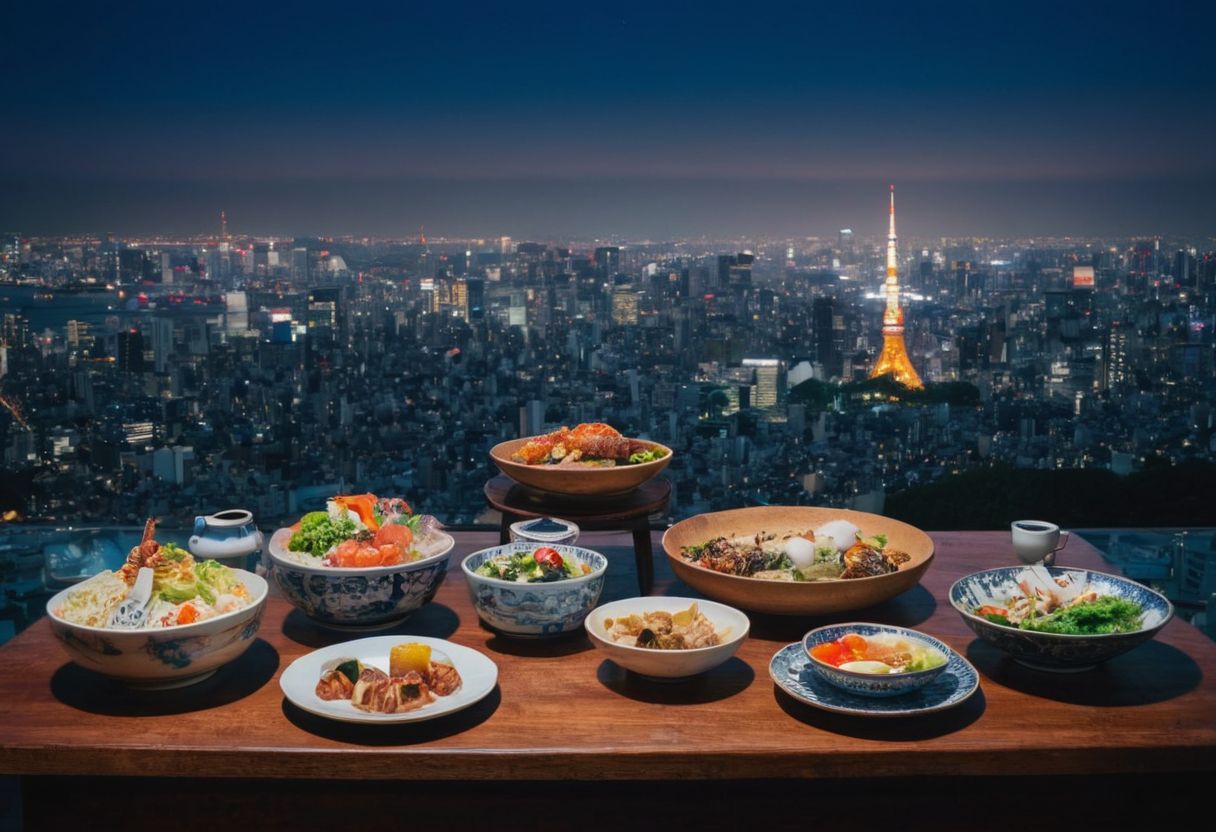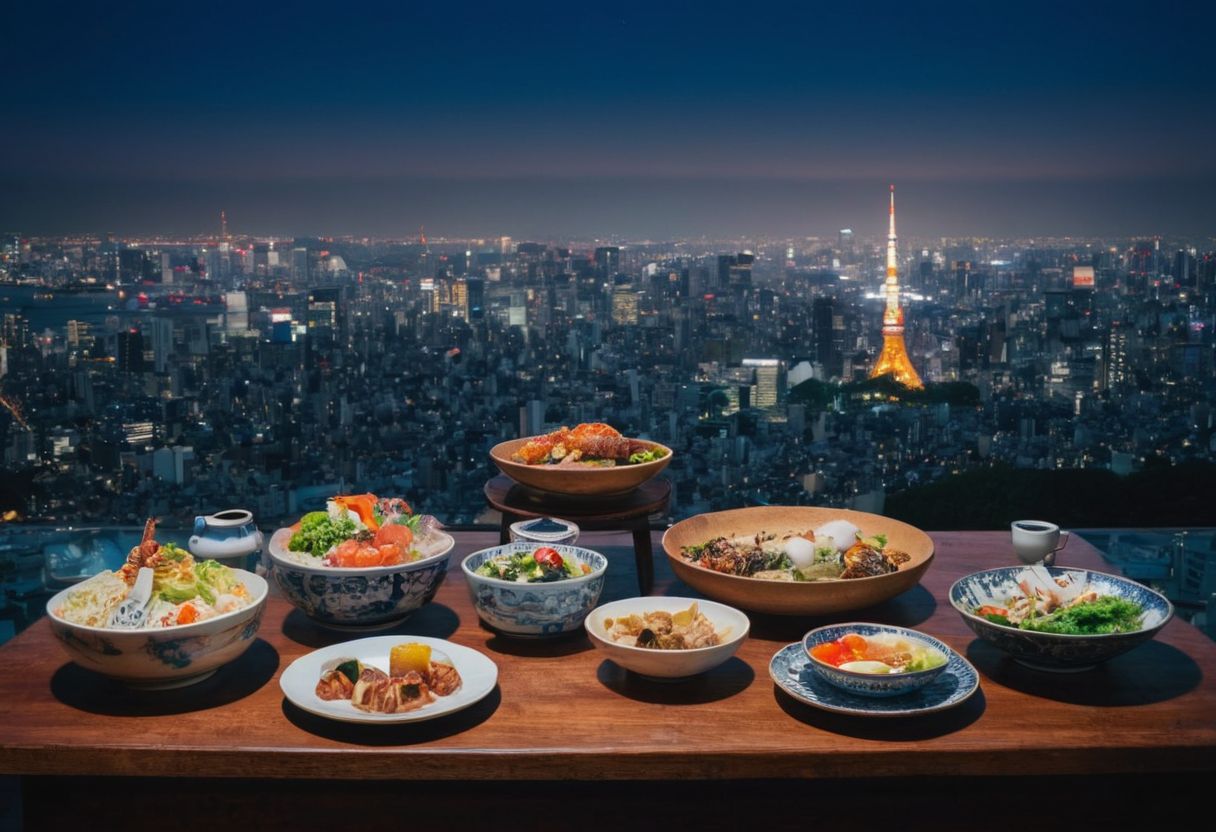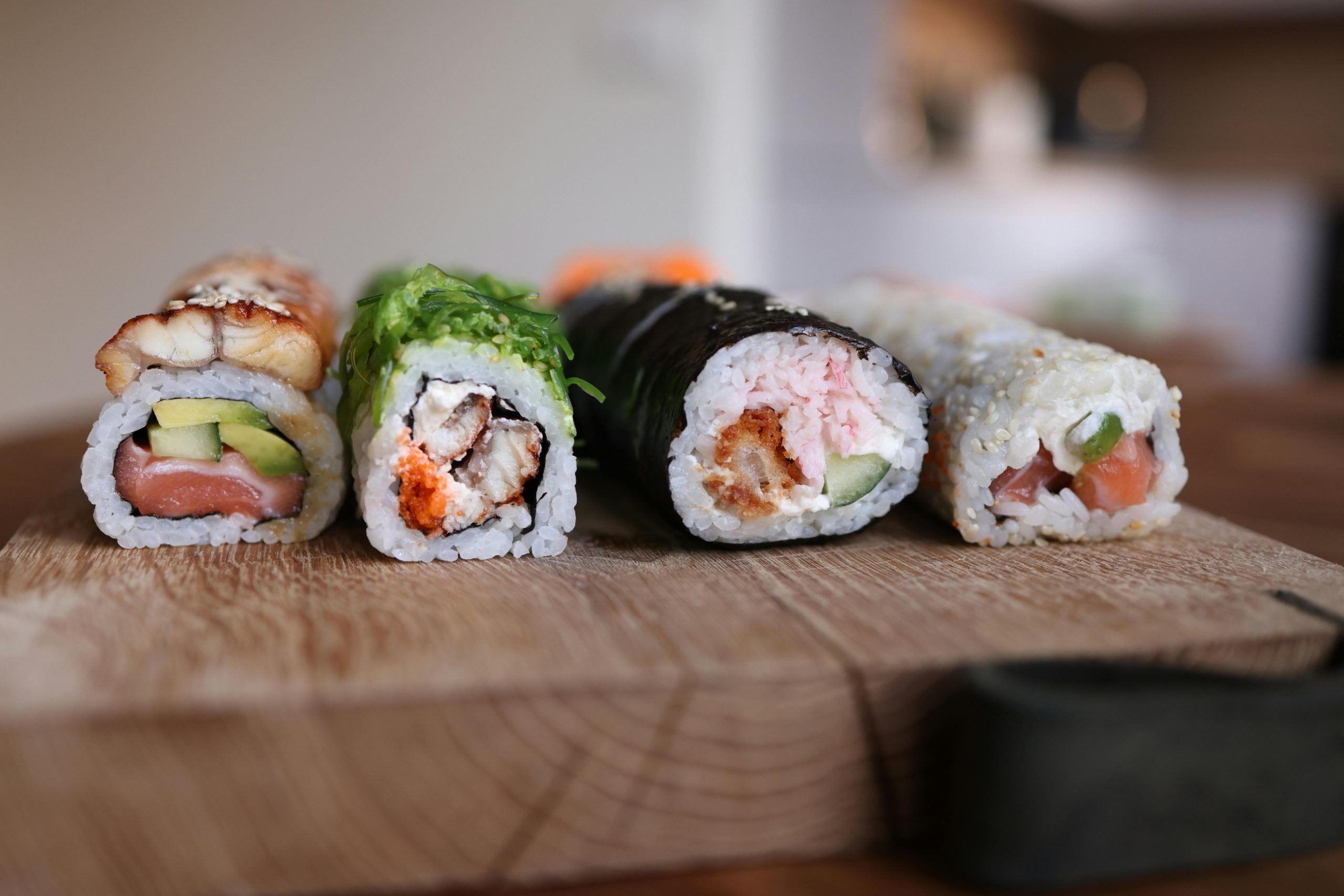Have you ever wondered about the allure of a kaiseki meal, Japan’s pinnacle of culinary sophistication?
Finding a truly authentic experience can be daunting, especially when trying to understand the intricate details and cultural significance behind each dish.
A kaiseki meal typically includes multiple courses such as appetizers, sashimi, cooked dishes, a rice course, and dessert, all crafted using seasonal ingredients to offer a harmonious blend of taste, texture, and presentation.
In this blog, we will delve into the historical origins, cultural insights, and various styles of kaiseki meals, guide you through the best places to experience them, and offer practical tips to enhance your dining journey.
The Historical Origins of the Kaiseki Meal
The kaiseki meal, a cornerstone of traditional Japanese cuisine, traces its origins back to the imperial courts of the Heian period (794-1185). Initially, these meals were elaborate banquets designed to impress guests with a variety of dishes that celebrated seasonal abundance. Over the centuries, the kaiseki evolved, intertwining with the practices of Zen Buddhism and the aesthetic of wabi-sabi, which appreciates the beauty in simplicity and impermanence. This historical blend of opulence and asceticism helped shape the kaiseki into a refined culinary art that balances taste, texture, and presentation.
The term ‘kaiseki’ itself holds significant meaning, derived from the kanji characters for ‘breast pocket stone’. This refers to the warm stones that Buddhist monks would place in their robes to ward off hunger during fasting periods. The influence of Zen Buddhism is evident in the kaiseki’s emphasis on minimalism and mindfulness, which are reflected in the careful selection of ingredients and the precise presentation of dishes. The evolution from a simple monks’ meal to a symbol of culinary excellence demonstrates the deep cultural and historical significance of the kaiseki tradition.
The Evolving Traditions of Kaiseki Meals
Kaiseki meals have undergone significant transformation from their humble beginnings in Buddhist monasteries to their current status as a symbol of Japanese haute cuisine. Originally consisting of simple dishes intended to support meditation, the traditional kaiseki now features multiple courses, each meticulously prepared to reflect the seasonal themes and the chef’s culinary artistry. This evolution marks a shift from the purely functional to an elaborate celebration of seasonal ingredients and artistic presentation.
Today’s kaiseki chefs continue to innovate while respecting the meal’s traditional roots. Each course in a kaiseki meal is designed to showcase different cooking techniques and flavors, with the sequence and ingredients often determined by the chef based on what is seasonally available. This approach not only highlights the chef’s creativity but also underscores the deep connection between Japanese cuisine and the natural world, a hallmark of kaiseki’s enduring appeal.
Cultural Insights into Kaiseki Meals
Kaiseki meals encapsulate a wide array of Japanese cultural values, particularly the appreciation of nature and the changing seasons. Each dish in a kaiseki menu is crafted to represent a specific seasonal theme, often using ingredients at the peak of their freshness. This practice not only enhances the flavor of the dishes but also connects diners with the natural world, fostering a deeper appreciation for the transient beauty of each season.
The cultural significance of kaiseki extends beyond the ingredients to the very atmosphere and etiquette of the dining experience. The setting of a kaiseki meal is carefully curated to create a tranquil environment, with elements such as subdued lighting and elegant tableware enhancing the overall sensory experience. Diners are encouraged to engage with the meal mindfully, appreciating the visual and taste nuances of each dish. This holistic approach to dining is reflective of broader Japanese aesthetics, which value harmony and attentiveness in every aspect of life.
Different Styles of Kaiseki Meals
Kaiseki meals, renowned for their elegance and artistry, come in various styles, each with unique characteristics in preparation and presentation. The traditional kaiseki, rooted in the tea ceremony, focuses on the seasonal and natural aesthetics, presenting dishes that are as visually appealing as they are delicious. These meals typically feature a sequence of dishes, each carefully crafted to harmonize with the season and occasion.
On the other hand, modern kaiseki styles might incorporate contemporary cooking techniques and ingredients, offering a new twist on the classic preparations. Regardless of the style, the essence of kaiseki is maintained through meticulous attention to detail, from the selection of seasonal ingredients to the artful presentation on specially chosen dishware. This dedication ensures each kaiseki meal is a unique culinary experience, reflecting the chef’s personal touch and the rich cultural heritage of Japanese cuisine.
Understanding the Courses in a Kaiseki Meal
A traditional kaiseki meal unfolds through multiple courses, each with its own significance and carefully selected ingredients. The meal typically begins with a light appetizer known as sakizuke, comparable to an amuse-bouche, designed to whet the appetite. This is followed by sashimi (raw fish), soup courses, and grilled and steamed dishes, each showcasing different cooking methods and flavors.
The progression of dishes in a kaiseki meal is not just about taste but also about celebrating the season’s best offerings. For example, the hassun course sets the seasonal theme with a mix of sushi and smaller side dishes. Towards the end of the meal, a shokuji (rice dish) followed by a mizumono (dessert) conclude the experience, leaving a lasting impression of the meal’s aesthetic and gastronomic journey. Each course is not only a feast for the palate but also for the eyes, with meticulous presentation and garnishing.
Where to Experience a Kaiseki Meal
To truly immerse in the tradition of Japanese kaiseki cuisine, Japan is the quintessential destination. Here, you can experience authentic kaiseki meals in settings that range from luxurious restaurants in Tokyo to serene ryokans in the countryside. These venues not only provide a meal but a full sensory experience, complete with traditional decor and sometimes even views of exquisite Japanese gardens.
Beyond Japan, the elegance of kaiseki meals has reached global cities like New York, London, and Paris. In these cities, chefs trained in the art of kaiseki use local ingredients to recreate the seasonal and artistic essence of traditional kaiseki dining. These international venues offer a fusion of local and Japanese culinary techniques, making the kaiseki experience accessible worldwide.
Top Kaiseki Restaurants in Kyoto
Kyoto is celebrated as the heartland of kaiseki cuisine, where dining transcends mere eating to become an art form. The city’s top kaiseki restaurants offer a deep dive into this culinary tradition, showcasing seasonal ingredients through meticulously crafted courses. These establishments, revered for their dedication to the art of kaiseki, provide not just meals but a comprehensive cultural experience.
Among the renowned spots, you’ll find venues like Gion Nishimura and Sakuragawa, known for their exceptional kaiseki courses. Each restaurant has its unique flair—whether it’s the ambiance, the chef’s innovative approach, or the exquisite presentation of dishes. Dining at these locations offers a memorable exploration of both traditional and contemporary kaiseki styles.
How to Reserve a Spot at a Kaiseki Restaurant
Securing a reservation at a kaiseki restaurant often requires planning and a bit of know-how. For the best experience, it’s advisable to book directly through the restaurant’s website if available, as this often provides the most straightforward and reliable method. Ensure you understand their cancellation policies, which can be strict due to the exclusivity and preparation required for each meal.
If direct online booking isn’t an option, contacting your hotel’s concierge service can be an effective alternative. They are usually well-equipped to handle reservations, even at high-end spots. Remember, especially for renowned kaiseki restaurants, it’s crucial to book well in advance—sometimes as early as a month or more, particularly if you are planning to dine during peak tourist seasons.
Dress Code for a Kaiseki Meal
When dressing for a kaiseki meal, the expected attire leans towards smart casual, striking a balance between comfort and respect for the dining experience. It’s not about formal wear, but you should avoid overly casual clothes like shorts and flip-flops. Men might consider a collared shirt with trousers, and women could opt for a dress or a blouse with a skirt or pants.
Since you will likely need to remove your shoes upon entering the restaurant, wearing presentable socks is a must. This small detail can impact your overall presentation and shows mindfulness towards Japanese dining etiquette. Avoid worn-out or mismatched socks, as maintaining a neat appearance contributes to the respectful atmosphere characteristic of kaiseki dining.
Budget-Friendly Kaiseki Meal Options
Enjoying a kaiseki meal doesn’t have to drain your wallet. There are several budget-friendly options that allow you to experience the elegance of kaiseki without the high price tag. Look for lunch specials at kaiseki restaurants, as they often offer the same meticulous presentation and quality at a fraction of the dinner cost. Additionally, smaller, less famous restaurants might provide a more affordable menu while still adhering to the traditional aspects of kaiseki.
Another way to enjoy kaiseki on a budget is by visiting culinary schools where students prepare meals as part of their training. These meals are typically much cheaper and offer a unique opportunity to experience upcoming culinary trends and techniques. Also, keep an eye out for seasonal promotions or special deals, especially during off-peak tourist seasons, when prices tend to be lower. By combining these strategies, you can savour the kaiseki experience without overspending.
Understanding the Cost of a Kaiseki Meal
Kaiseki meals, celebrated for their culinary sophistication, vary widely in cost, primarily depending on the venue and the intricacy of the meal. Prices for a full-course dinner can range from 5,000 yen to over 40,000 yen per person, excluding drinks. This price variability reflects the quality of ingredients used, the skill level of the chef, and the overall dining experience provided.
For those looking for a more budget-friendly option, considering a kaiseki lunch might be beneficial. Lunch menus typically offer a similar experience at a lower cost, ranging from 4,000 to 8,000 yen. Additionally, some restaurants offer bento versions of kaiseki meals, which can cost between 2,000 to 4,000 yen, providing an affordable yet authentic taste of this exquisite culinary art.
Tips for Enjoying a Kaiseki Meal in Japan
To fully appreciate a kaiseki meal in Japan, immerse yourself in the cultural nuances that define this dining experience. Begin by arriving on time or slightly early, as punctuality reflects respect in Japanese culture. It’s also prudent to familiarise yourself with basic Japanese dining etiquette such as using chopsticks correctly and not pointing them towards others. These small acts of cultural awareness can significantly enhance your dining experience.
During the meal, focus on the sequence and presentation of dishes, as each is meticulously planned to reflect seasonal themes and culinary artistry. Here are a few practical tips to elevate your experience:
- Savor each dish slowly, paying attention to the subtle flavors and textures.
- Ask questions if you’re curious about ingredients or preparation methods, as most chefs take pride in their craft and appreciate engaged diners.
- Express gratitude by saying ‘gochisosama deshita’ at the end of your meal, which conveys appreciation for the food and the effort that went into preparing it.
Enhance Your Kaiseki Experience with Indulge’s Culinary Tours
While kaiseki is a quintessentially Japanese experience, INDULGE offers a unique opportunity to deepen your understanding of culinary artistry through its curated tours in Zurich. By exploring the rich culinary heritage of Zurich with INDULGE, you can gain insights that are surprisingly complementary to the Japanese kaiseki. For instance, the emphasis on seasonal ingredients and meticulous presentation is a common thread that runs through both these culinary traditions.
INDULGE’s guided tours not only highlight the local Swiss cuisine but also introduce participants to international culinary practices, including aspects similar to kaiseki. These tours, led by expert chefs and sommeliers, offer:
- A deep dive into the history and culture behind famous dishes
- An exploration of how local ingredients are transformed into high art, mirroring the kaiseki philosophy
- Exclusive dining experiences that echo the multisensory satisfaction of a kaiseki meal, making every INDULGE tour a journey through taste and tradition.
Frequently Asked Questions
What is in a kaiseki meal?
A kaiseki meal typically includes multiple courses such as appetizers, sashimi, cooked dishes, a rice course, and dessert, all crafted using seasonal ingredients to offer a harmonious blend of taste, texture, and presentation.
How many courses is a kaiseki meal?
A traditional kaiseki meal unfolds through multiple courses, including a light appetizer, sashimi, soup courses, grilled and steamed dishes, a rice dish, and dessert.








